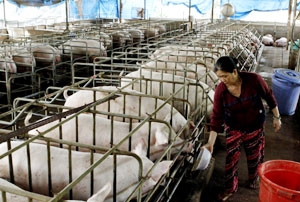
Dong Nai province, the country's largest animal husbandry producer, plans to invest VND3 trillion (US$142 million) to develop livestock, poultry and aquatic cultivation through 2020.
 |
| In Xuan Dinh Commune, Dong Nai Province, pigs are raised on a large scale in modern facilities, rather than in traditional household farms . The province plans to invest over $140 million to boost its husbandry by 2020 |
Dong Nai province, the country's largest animal husbandry producer, plans to invest VND3 trillion (US$142 million) to develop livestock, poultry and aquatic cultivation through 2020.
The provincial People's Committee said it had collected opinions about the plan from several departments and agencies.
Under the proposal, the province would establish large-scale cultivation areas to increase the total production of pigs, chicken and aquatic species.
It calls for 2.2 million heads of pig, with a total output of 250,000 tonnes a year by 2020. Farms would account for up to 80 per cent and individual farmers for 20 per cent of production.
The plan also aims to increase the province's chicken population to 13 million heads, with 95 per cent of them raised on farms.
It will also support the building and developing of hygienic supply chains of pig and poultry meat products and eggs.
By 2020, 30 per cent of the province's aquaculture area would meet Vietnamese Good Agricultural Practice standards.
Dong Nai currently has a pig population of about 1.3 million heads, according to the province's Department of Agriculture and Rural Development.
Many pig and chicken raisers in the province have faced severe losses this year as prices have fallen lower than production costs.
Chicken is selling for VND8,000-12,000 per kilo lower than production cost this year.
Disease outbreaks are one of the major reasons behind the price decline. About 60 per cent of livestock in the province are now being raised on farms.
(Source: VNS)



